 swiss chard, pansies and alyssum
swiss chard, pansies and alyssum
Deborah Silver is an accomplished and experienced landscape and garden designer whose firm first opened its doors in 1986.
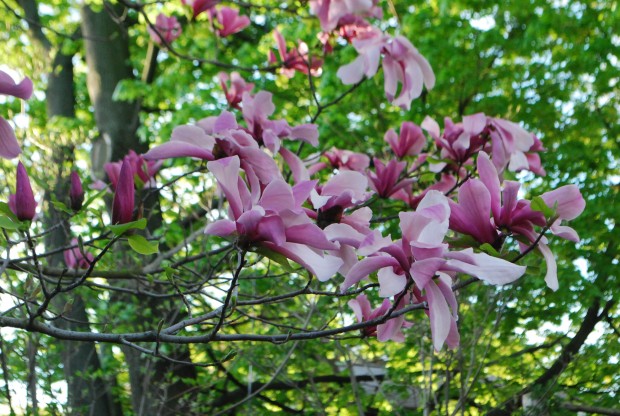 In most every year I have written this blog, there is an essay about magnolias. I have a big love for them. The flowers are dramatic and showy-I so welcome a gesture of this magnitude after a long winter. A good bloom is never a certainty. They bloom early in my spring-which also means they bloom late in my winter. Last year, given a string of April days in the low twenties, every bud was reduced to a gooey black rotted mess, hanging from the branches. That hanging persisted well into the summer-a vile reminder of the capricious nature of spring weather.
In most every year I have written this blog, there is an essay about magnolias. I have a big love for them. The flowers are dramatic and showy-I so welcome a gesture of this magnitude after a long winter. A good bloom is never a certainty. They bloom early in my spring-which also means they bloom late in my winter. Last year, given a string of April days in the low twenties, every bud was reduced to a gooey black rotted mess, hanging from the branches. That hanging persisted well into the summer-a vile reminder of the capricious nature of spring weather.
 But when the magnolias are good, they are very very good. My neighborhood has plenty of old saucer magnolias in evidence. Some are planted very close to the foundations of homes-they do not seem to mind this. Many have multiple trunks that have grown to considerable size. A saucer magnolia in full bloom is heart stoppingly beautiful. My saucer magnolias are a hybrid of magnolia soulangiana, named Galaxy. The day I planted the three of them in my driveway garden, they had long spindly arms-gawky, they were. The one tree with the most sun has grown to a considerable size.
But when the magnolias are good, they are very very good. My neighborhood has plenty of old saucer magnolias in evidence. Some are planted very close to the foundations of homes-they do not seem to mind this. Many have multiple trunks that have grown to considerable size. A saucer magnolia in full bloom is heart stoppingly beautiful. My saucer magnolias are a hybrid of magnolia soulangiana, named Galaxy. The day I planted the three of them in my driveway garden, they had long spindly arms-gawky, they were. The one tree with the most sun has grown to a considerable size.
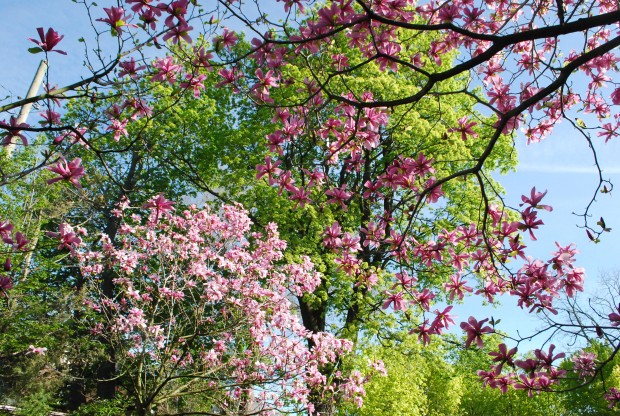 The second tree will catch up to tree number one in the next few years. Tree 3 took a giant hit in the trunk from a careless truck driver in the driveway. Late this winter I took down an old Norway maple in this area whose girdling roots have been hard at work squeezing the life out of it. So little of the canopy was green last year-looking at it made me wince. It was time to give up the maple, in the interest of the health of the magnolias-and a group of parrotias.
The second tree will catch up to tree number one in the next few years. Tree 3 took a giant hit in the trunk from a careless truck driver in the driveway. Late this winter I took down an old Norway maple in this area whose girdling roots have been hard at work squeezing the life out of it. So little of the canopy was green last year-looking at it made me wince. It was time to give up the maple, in the interest of the health of the magnolias-and a group of parrotias.
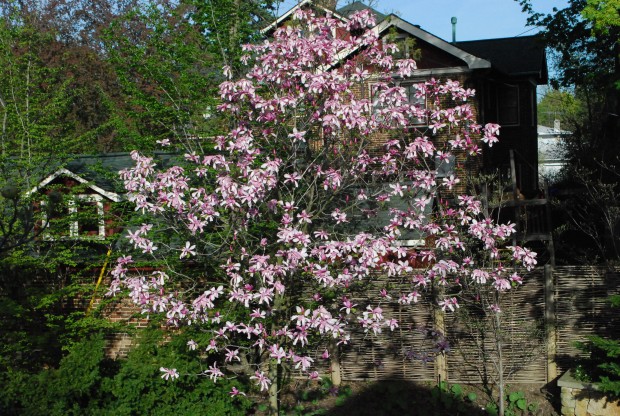 This cool spring made for a glorious magnolia bloom season. I admired them up close. I stood under their blossom laden branches. I admired them from afar. Why this love of magnolias? The spectacular bloom aside, they are a very handsome tree. The grey bark is beautiful. The mossed bark on old trees-sensational. The leaves are large, and glossy. Their winter shape is strikingly architectural. They are beautiful trees, no matter the season. Their mature size is a size that any modest city property such as my own, could accommodate. I have a city lot and a half, which is home to 11 magnolias-no kidding.
This cool spring made for a glorious magnolia bloom season. I admired them up close. I stood under their blossom laden branches. I admired them from afar. Why this love of magnolias? The spectacular bloom aside, they are a very handsome tree. The grey bark is beautiful. The mossed bark on old trees-sensational. The leaves are large, and glossy. Their winter shape is strikingly architectural. They are beautiful trees, no matter the season. Their mature size is a size that any modest city property such as my own, could accommodate. I have a city lot and a half, which is home to 11 magnolias-no kidding. 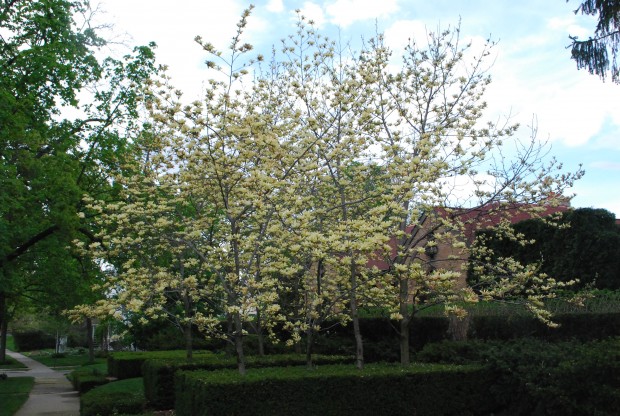
8 of my magnolias are planted in the half lot, in the front of my yard. They are under planted with boxwood. They are yellow magnolias-yes yellow. Hybridized by Phil Savage, the blooms of the magnolia “Butterflies” are the most astonishingly gorgeous pale yellow imaginable. I met Phil Savage when I was young, and working for Al Goldner. Al was a landscape designer who owned a nursery. He loved plants-and he loved design. I was so lucky for my exposure to him, and his work. Al made it his business to introduce anyone designing for him to people who grew great plants. So many years later, I treasure that experience.
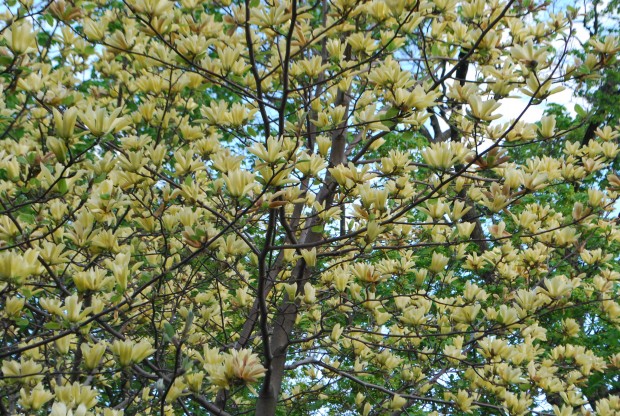 Phil owned a large property in my area. Though he passed away a few years ago, that property is loaded with magnolias-many of which exceed 60 feet in height. I had occasion to see his trees in full bloom a few years ago, courtesy of a niece, who is a client. I was astonished at what I saw. Yellow, peach, pale pink and hot pink flowers on magnolias that towered high above the ground. My pictures of his property are so bad-I would not publish them. But the experience of his vision about magnolias-this I will never forget. This is why I plant magnolias, any time I have the chance.
Phil owned a large property in my area. Though he passed away a few years ago, that property is loaded with magnolias-many of which exceed 60 feet in height. I had occasion to see his trees in full bloom a few years ago, courtesy of a niece, who is a client. I was astonished at what I saw. Yellow, peach, pale pink and hot pink flowers on magnolias that towered high above the ground. My pictures of his property are so bad-I would not publish them. But the experience of his vision about magnolias-this I will never forget. This is why I plant magnolias, any time I have the chance.
The bloom, even in a really great year, is not long. Should you need more than that momentary experience of their shockingly beautiful flowers, consider their leaves, and their gorgeous shape. I for one do not mind an experience of the garden that is fleeting. Every season has its perfect moment. I do not need any plant, any garden, or any landscape to to do more than their season. I do not hold the brevity of a season against any tree. As for Phil Savage’s property-yes. It has been sold. The buyer I would guess has no interest in that magnolia forest the likes of which I am sure does not exist any where else on this planet. The new owner has another idea in mind. I hear from friends and colleagues in the growing community that there is a plan to take cuttings. I so pray this plan comes to be.
A plan to preserve and nurture the magnolias bred by Phil Savage-this seems a fitting essay for Mother’s Day weekend.
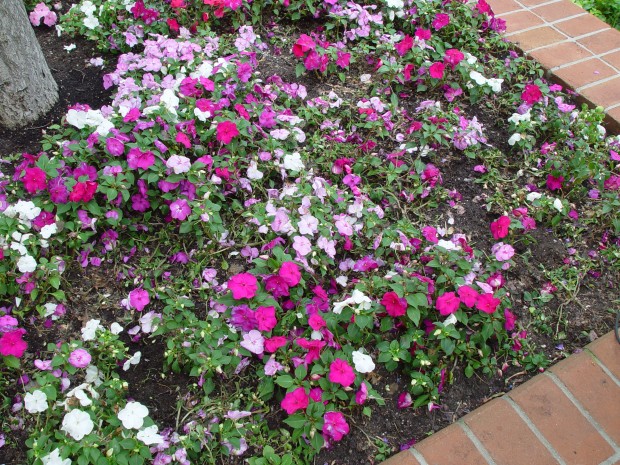 I have a big love for all of the annual plants that are available to augment my garden. Many of them come from tropical climates. One of the most popular annual plants of all time is impatiens walleriana. This plant grows readily in the heat, and covers itself with self cleaning flowers in a wide range of colors. Impatiens also tolerates a good bit of shade. They are happy in the sun, given sufficient water. They are the workhorse of annual shade bedding plants. That said, the impatiens are sick. A fungal disease that causes the plants to collapse in a rotten mess has infected our area. This picture, taken in 2009, at the one place I plant impatiens, tells the tale. I was so sure the client was over watering. I know now the plants were diseased. This devastating disease has affected impatiens plants all over the globe. There has been lots of discussion about planting impatiens this year in my area. I believe those major growers who are brave enough to suggest the disease is currently inherent in the seed. The upshot-should you find a nursery this season who still offers impatiens for sale, be advised that your purchase comes with an expiration date. Preventative applications of fungicide may stave off the disease, but once the disease is present, there is no cure. Any places planted with impatiens last year should not be replanted with them this year. No matter how much you love impatiens, the look of the plants in the picture above is not a good look.
I have a big love for all of the annual plants that are available to augment my garden. Many of them come from tropical climates. One of the most popular annual plants of all time is impatiens walleriana. This plant grows readily in the heat, and covers itself with self cleaning flowers in a wide range of colors. Impatiens also tolerates a good bit of shade. They are happy in the sun, given sufficient water. They are the workhorse of annual shade bedding plants. That said, the impatiens are sick. A fungal disease that causes the plants to collapse in a rotten mess has infected our area. This picture, taken in 2009, at the one place I plant impatiens, tells the tale. I was so sure the client was over watering. I know now the plants were diseased. This devastating disease has affected impatiens plants all over the globe. There has been lots of discussion about planting impatiens this year in my area. I believe those major growers who are brave enough to suggest the disease is currently inherent in the seed. The upshot-should you find a nursery this season who still offers impatiens for sale, be advised that your purchase comes with an expiration date. Preventative applications of fungicide may stave off the disease, but once the disease is present, there is no cure. Any places planted with impatiens last year should not be replanted with them this year. No matter how much you love impatiens, the look of the plants in the picture above is not a good look.
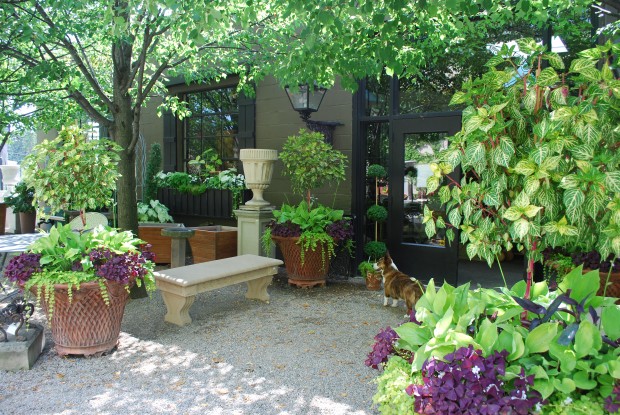 The list of annual and tropical plants that tolerate shady locations is considerable. The toughest part is getting past the fact that a favorite plant in a favorite color is not available. On the positive side, adverse conditions can produce some very interesting and creative results. Green shade plants such as the irisine standards pictures, hostas, creeping jenny are not prized for their flowers, but the leaves are strikingly colorful. The same goes for the oxalis and Moses in the cradle. The flowers are not so showy, but the leaf color is spectacular.
The list of annual and tropical plants that tolerate shady locations is considerable. The toughest part is getting past the fact that a favorite plant in a favorite color is not available. On the positive side, adverse conditions can produce some very interesting and creative results. Green shade plants such as the irisine standards pictures, hostas, creeping jenny are not prized for their flowers, but the leaves are strikingly colorful. The same goes for the oxalis and Moses in the cradle. The flowers are not so showy, but the leaf color is spectacular.
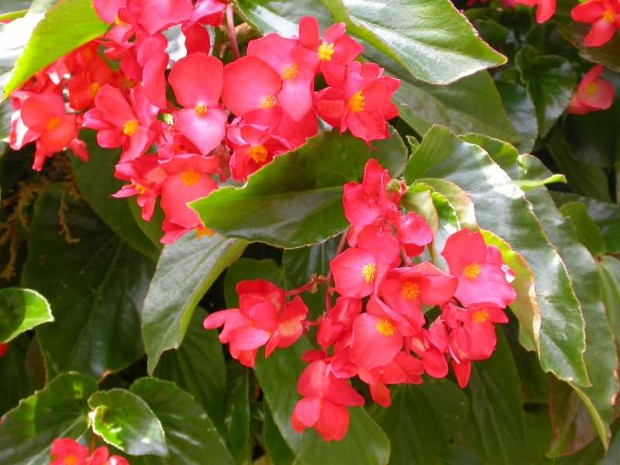 Dragon wing begonias are quite tolerant of shade, though the colors tend towards the yellow reds, coral and orange-not at all like the bluish pinks so common in impatiens. The appearance of the color of this plant has everything to do with the color of its companion plants. Yellow will make this flower appear more coral orange. A red violet companion makes this begonia appear more rose red.
Dragon wing begonias are quite tolerant of shade, though the colors tend towards the yellow reds, coral and orange-not at all like the bluish pinks so common in impatiens. The appearance of the color of this plant has everything to do with the color of its companion plants. Yellow will make this flower appear more coral orange. A red violet companion makes this begonia appear more rose red.
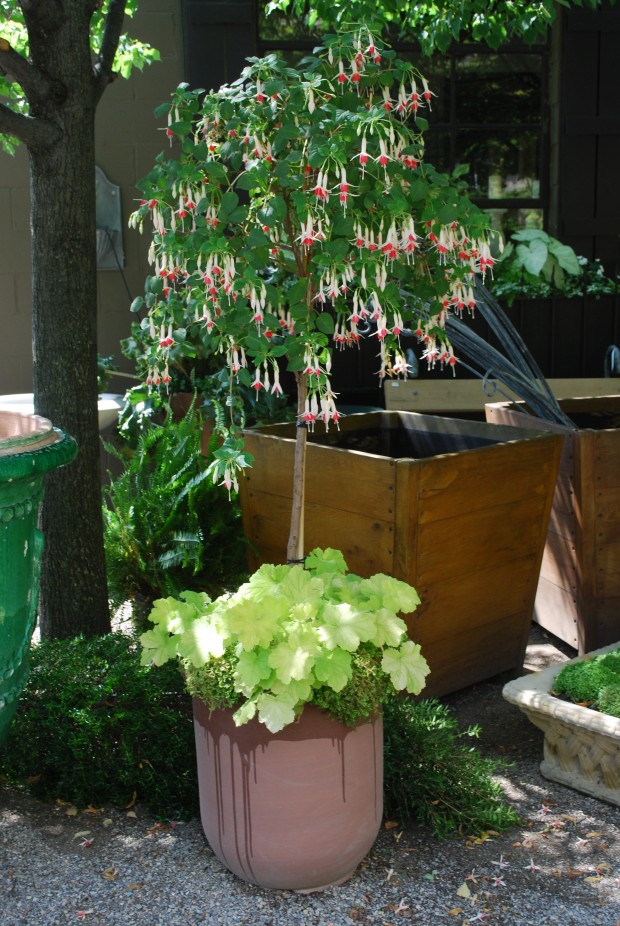 Fuchsia flowers may be small, but they have a very interesting shape, and come in a wide range of colors. A fuchsia on standard makes a great centerpiece in a container planted for shade. This fuchsia “Ballerina” will flower next to a north wall, all summer long.
Fuchsia flowers may be small, but they have a very interesting shape, and come in a wide range of colors. A fuchsia on standard makes a great centerpiece in a container planted for shade. This fuchsia “Ballerina” will flower next to a north wall, all summer long.
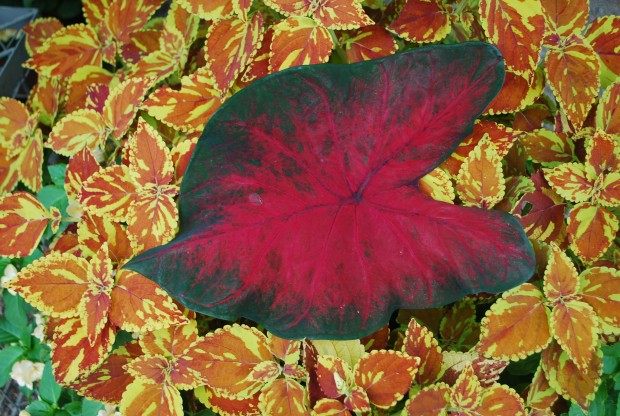 Few shade tolerant annuals can rival coleus and caladiums for dramatic color and form. For many years coleus did not interest me that much. The colors looked so muddy. New cultivars have very clear and vibrant colors. They old standard caladiums have a lot more company these days. The arrow and strap leaf caladiums have a saucy shape, and are visible from quite a distance. The new white cultivars are very bright in shady locations.
Few shade tolerant annuals can rival coleus and caladiums for dramatic color and form. For many years coleus did not interest me that much. The colors looked so muddy. New cultivars have very clear and vibrant colors. They old standard caladiums have a lot more company these days. The arrow and strap leaf caladiums have a saucy shape, and are visible from quite a distance. The new white cultivars are very bright in shady locations. 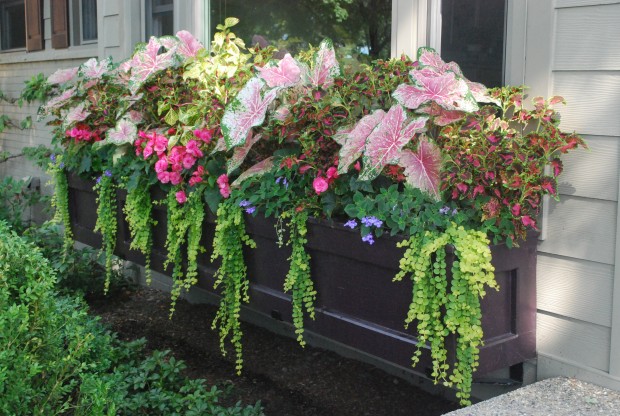 Variety is the spice of life, yes? In my opinion, the planting in this window box is much more visually interesting than a mass of impatiens. A good design assembles a collection of materials that look good together. Sometimes, the relationship between one element and another is vastly more interesting that the individual element alone. I do understand that there is a financial aspect to the impatiens debacle. An impatiens plant runs between .25 and .40 each. A single 4″ pot of coleus is 10 times that much. But many growers are offering coleus and seed New Guinea impatiens in flats. Some larger growing shade annuals can be found in 6 packs-18 plants to a flat. Other alternatives? Take the most ordinary white fibrous begonias in flats, and plant them in interesting shapes, swirls and stripes. Make the statement with a shape, rather than a specific variety. Impatiens has a tendency to get massive and shapeless by summer’s end. A planting of white or pick or red fibrous begonias can hold an intricate shape or pattern. A mix of three colors is more sparkly and interesting than one color. Those begonias can be punctuated with a 4″ pot of some other shade tolerant annual every so often. Another tip-fibrous begonias with dark leaves have a dour muddy look-stick with the green leaved varieties, unless you have a whole “other than green” foliage idea in mind.
Variety is the spice of life, yes? In my opinion, the planting in this window box is much more visually interesting than a mass of impatiens. A good design assembles a collection of materials that look good together. Sometimes, the relationship between one element and another is vastly more interesting that the individual element alone. I do understand that there is a financial aspect to the impatiens debacle. An impatiens plant runs between .25 and .40 each. A single 4″ pot of coleus is 10 times that much. But many growers are offering coleus and seed New Guinea impatiens in flats. Some larger growing shade annuals can be found in 6 packs-18 plants to a flat. Other alternatives? Take the most ordinary white fibrous begonias in flats, and plant them in interesting shapes, swirls and stripes. Make the statement with a shape, rather than a specific variety. Impatiens has a tendency to get massive and shapeless by summer’s end. A planting of white or pick or red fibrous begonias can hold an intricate shape or pattern. A mix of three colors is more sparkly and interesting than one color. Those begonias can be punctuated with a 4″ pot of some other shade tolerant annual every so often. Another tip-fibrous begonias with dark leaves have a dour muddy look-stick with the green leaved varieties, unless you have a whole “other than green” foliage idea in mind. 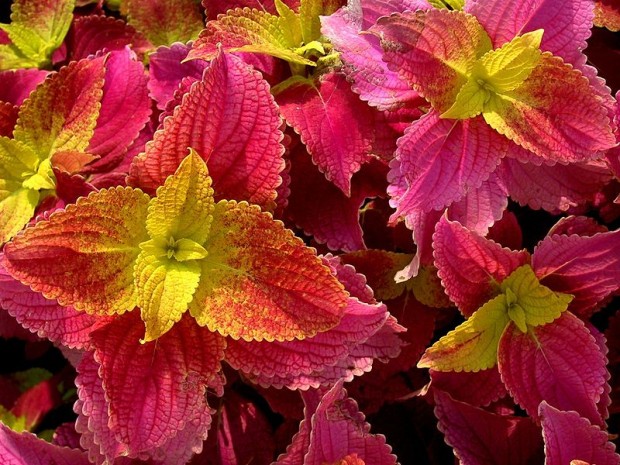 But the best of this bad situation is a chance to become acquainted with plants you may have passed by before. There are some very beautiful plants out there, looking for a home for the summer.
But the best of this bad situation is a chance to become acquainted with plants you may have passed by before. There are some very beautiful plants out there, looking for a home for the summer.
 coleus and solenia orange begonias
coleus and solenia orange begonias
 This container does have a dash of color courtesy of a blob of lipstick impatiens. But that impatiens is by no means the star of this show.
This container does have a dash of color courtesy of a blob of lipstick impatiens. But that impatiens is by no means the star of this show.
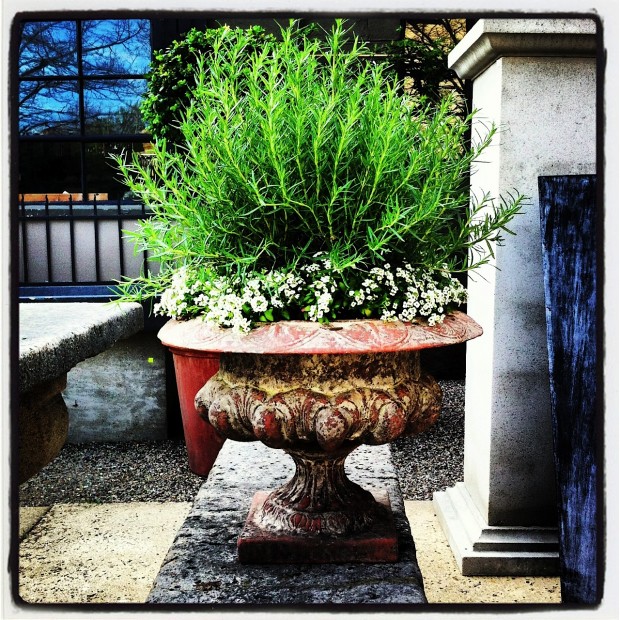 It’s hard to pick a favorite, but the spring season has an aura like no other. Any plant, whether it be a tree or summer flowering shrub, a bulb or a perennial, responds to nature’s call to break dormancy, and grow. From the biggest maple to the smallest hepatica, the plants are growing. There is a lot of commotion in the air. The plants are not pacing themselves, as they do in the heat of the summer. They are not slowing down, as in the fall. Or asleep, as in winter. It’s full speed ahead. The atmosphere in the garden is fully charged, electrified by all that energy being brought to bear-all at once- on the landscape. Rob has been taking instagram pictures the past few days. The options for filtering and electrifying color makes this spring container really feel like spring.
It’s hard to pick a favorite, but the spring season has an aura like no other. Any plant, whether it be a tree or summer flowering shrub, a bulb or a perennial, responds to nature’s call to break dormancy, and grow. From the biggest maple to the smallest hepatica, the plants are growing. There is a lot of commotion in the air. The plants are not pacing themselves, as they do in the heat of the summer. They are not slowing down, as in the fall. Or asleep, as in winter. It’s full speed ahead. The atmosphere in the garden is fully charged, electrified by all that energy being brought to bear-all at once- on the landscape. Rob has been taking instagram pictures the past few days. The options for filtering and electrifying color makes this spring container really feel like spring.
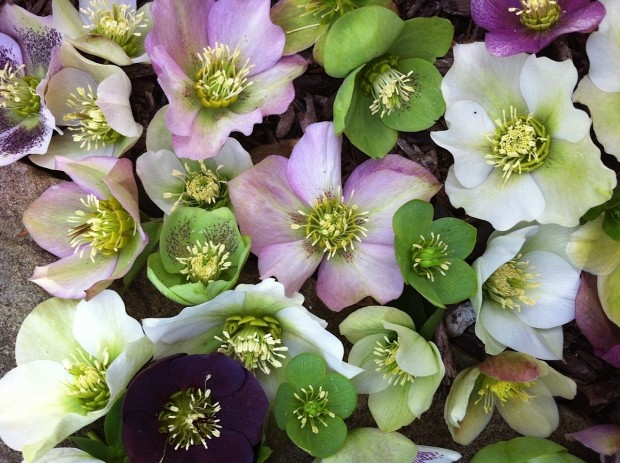 Each of these hellebore flowers tells a story about my collection. I have a fair number of plants. I especially appreciate the form of the flowers. But what I love about them the best is that they make a grand show in the spring. The hellebores coming into bloom are like the bells of spring ringing out. They are quite hardy. Old clumps are large; the foliage is evergreen until mid winter for me.
Each of these hellebore flowers tells a story about my collection. I have a fair number of plants. I especially appreciate the form of the flowers. But what I love about them the best is that they make a grand show in the spring. The hellebores coming into bloom are like the bells of spring ringing out. They are quite hardy. Old clumps are large; the foliage is evergreen until mid winter for me.
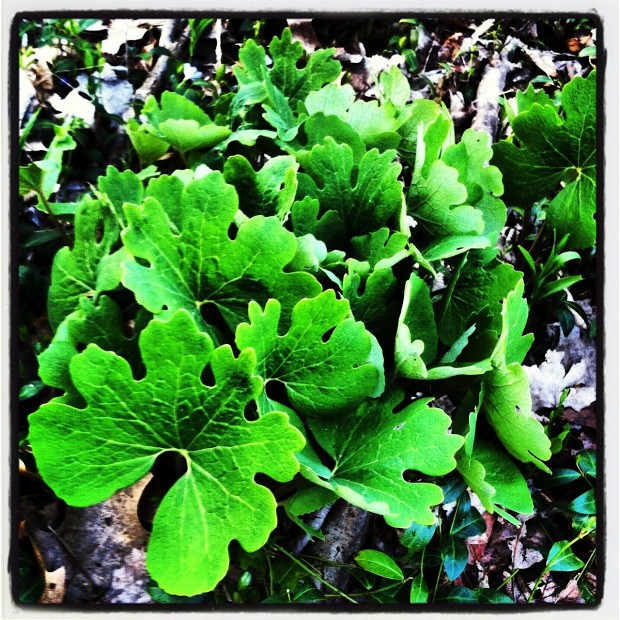 Sanguinaria, or bloodroot, is a native Michigan wildflower. A single leaf rises out of the ground, entirely curled around a single flower bud on its own leafless stalk. What a story this is, yes? The single white flowers are open for a few days at best, before the petals drop. If you do not check the emerging plant often in the spring, it could be you will miss the flower altogether. The small leaves are strikingly shaped and veined. Soon after flowering, the plant will go dormant until the following year. The spring season can be fraught with icy and windy weather. Though it is the same length as all of the other seasons, spring seems to come and go in an instant. The time of the bloodroot- hours.
Sanguinaria, or bloodroot, is a native Michigan wildflower. A single leaf rises out of the ground, entirely curled around a single flower bud on its own leafless stalk. What a story this is, yes? The single white flowers are open for a few days at best, before the petals drop. If you do not check the emerging plant often in the spring, it could be you will miss the flower altogether. The small leaves are strikingly shaped and veined. Soon after flowering, the plant will go dormant until the following year. The spring season can be fraught with icy and windy weather. Though it is the same length as all of the other seasons, spring seems to come and go in an instant. The time of the bloodroot- hours.
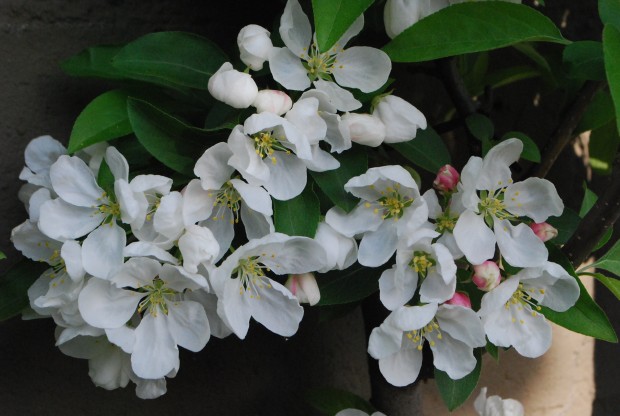 The crabapple “Donald Wyman” has bright pink buds, and a profusion of white flowers. A crabapple blanketed in flowers is one of spring’s most breathtaking events. In a cool spring season, they are a delight to the eye for a week or better. The teardrop shaped petals-how do they manage to stay attached on a windy spring day? Crabapples in bloom-glorious.
The crabapple “Donald Wyman” has bright pink buds, and a profusion of white flowers. A crabapple blanketed in flowers is one of spring’s most breathtaking events. In a cool spring season, they are a delight to the eye for a week or better. The teardrop shaped petals-how do they manage to stay attached on a windy spring day? Crabapples in bloom-glorious.
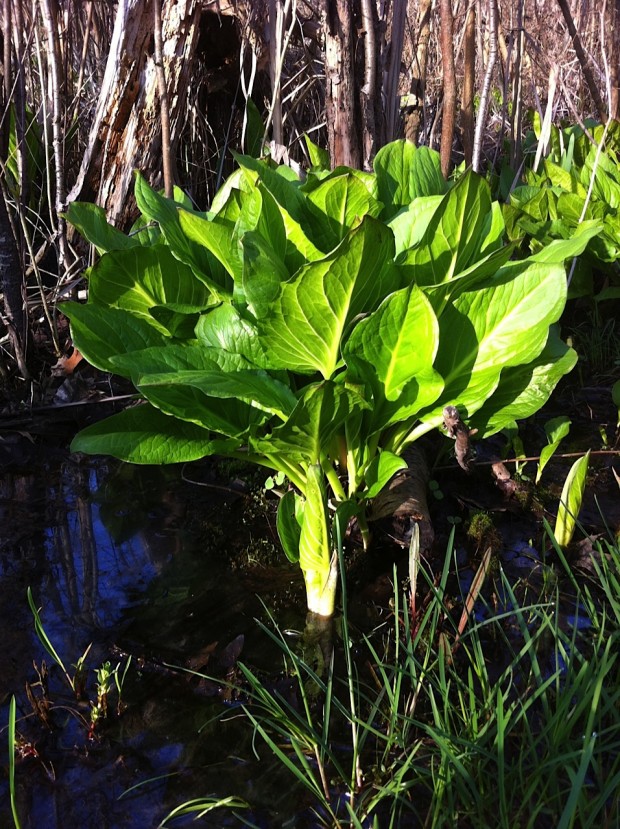 In swampy areas, the skunk cabbage forms massive leafy clumps that look good enough to eat. However, skunk cabbage is poisonous to mammals. The plants will warn you. The leaves when disturbed smell like rotten meat. This spring beauty has luscious looks, but should be admired from afar.
In swampy areas, the skunk cabbage forms massive leafy clumps that look good enough to eat. However, skunk cabbage is poisonous to mammals. The plants will warn you. The leaves when disturbed smell like rotten meat. This spring beauty has luscious looks, but should be admired from afar.
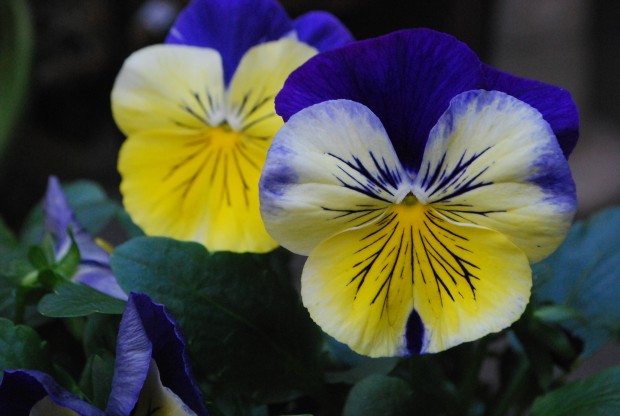 Today’s pansies and violas look much different than their more self effacing ancestors. This particular bicolor pansy, with its distinctive dark whiskers, is saturated with intense color. This is spring blooming at its most robust. Though the pansies and violas do not really pick up steam, and flower heavily until the beginning of June, each individual face announces the coming of spring in the most cheery way imaginable. They are so unlike any other flower in form and color. Fault me if you wish, but a pansy in August would be out of place. They belong to spring.
Today’s pansies and violas look much different than their more self effacing ancestors. This particular bicolor pansy, with its distinctive dark whiskers, is saturated with intense color. This is spring blooming at its most robust. Though the pansies and violas do not really pick up steam, and flower heavily until the beginning of June, each individual face announces the coming of spring in the most cheery way imaginable. They are so unlike any other flower in form and color. Fault me if you wish, but a pansy in August would be out of place. They belong to spring.
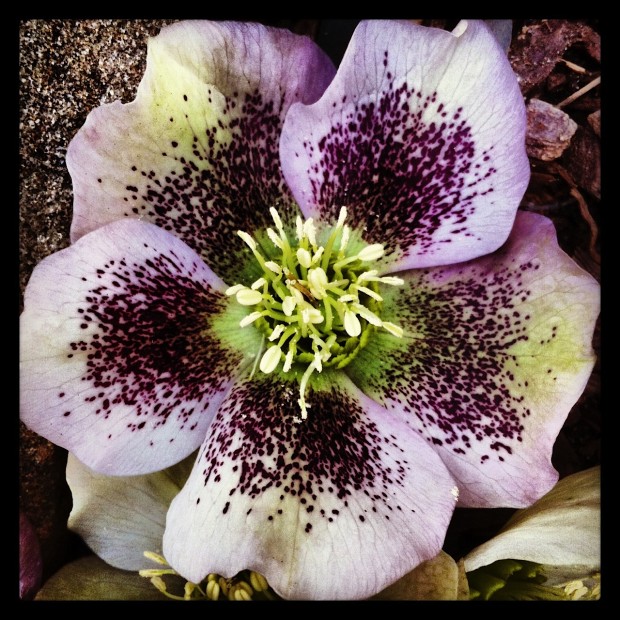 Rob’s instagram photograph of a dark speckled hellebore proves that spring can also be moody and sultry . Rainy and chilly. It also makes the point loud and clear that the atmosphere of a landscape can be altered by light and color-to spectacular effect. Creating a mood, or an atmosphere in a garden is one of the most difficult aspects of landscape design. It cannot be taught, nor can it be forced. It can be aspired to. Spring is that season that every gardener can turn loose of the past, and start fresh. The sap rises in the plants and the gardeners alike.
Rob’s instagram photograph of a dark speckled hellebore proves that spring can also be moody and sultry . Rainy and chilly. It also makes the point loud and clear that the atmosphere of a landscape can be altered by light and color-to spectacular effect. Creating a mood, or an atmosphere in a garden is one of the most difficult aspects of landscape design. It cannot be taught, nor can it be forced. It can be aspired to. Spring is that season that every gardener can turn loose of the past, and start fresh. The sap rises in the plants and the gardeners alike.
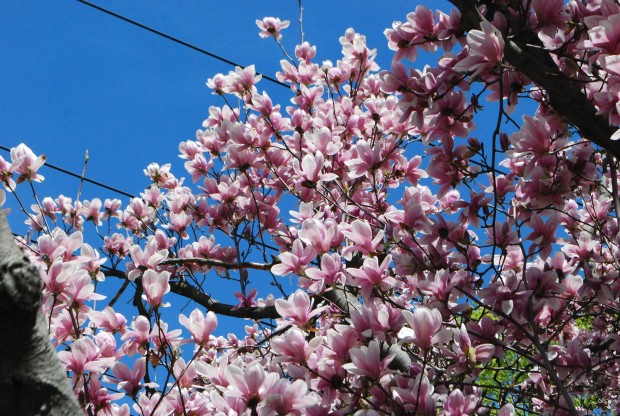 The saucer magnolia features very large flowers of great substance. The queen bee/Sarah Bernhardt of the spring flowering trees, this magnolia likes cool spring temperatures, but not too cool. Warm spring temperatures, but not too warm. A good bloom demands next to perfect conditions as if it were a God given right. It seems like every Michigan spring features some weather element or another which causes all of the petals to fall to the ground in a heap. A thick mulch of magnolia petals on the ground-that would be our spring.
The saucer magnolia features very large flowers of great substance. The queen bee/Sarah Bernhardt of the spring flowering trees, this magnolia likes cool spring temperatures, but not too cool. Warm spring temperatures, but not too warm. A good bloom demands next to perfect conditions as if it were a God given right. It seems like every Michigan spring features some weather element or another which causes all of the petals to fall to the ground in a heap. A thick mulch of magnolia petals on the ground-that would be our spring.
Deborah Silver is a landscape and garden designer whose firm, Deborah Silver and Co Inc, opened its doors in 1986. She opened Detroit Garden Works, a retail store devoted to fine and unusual garden ornament and specialty plants, in 1996. In 2004, she opened the Branch studio, a subsidiary of the landscape company which designs and manufactures garden ornament in a variety of media. Though her formal education is in English literature and biology, she worked as a fine artist in watercolor and pastel from 1972-1983. A job in a nursery, to help support herself as an artist in the early 80’s evolved into a career in landscape and garden design. Her landscape design and installation projects combine a thorough knowledge of horticulture with an artist’s eye for design. Her three companies provide a wide range of products and services to the serious gardener. She has been writing this journal style blog since April of 2009.
Copyright © 2024 · Deborah Silver & Co. · Detroit Garden Works